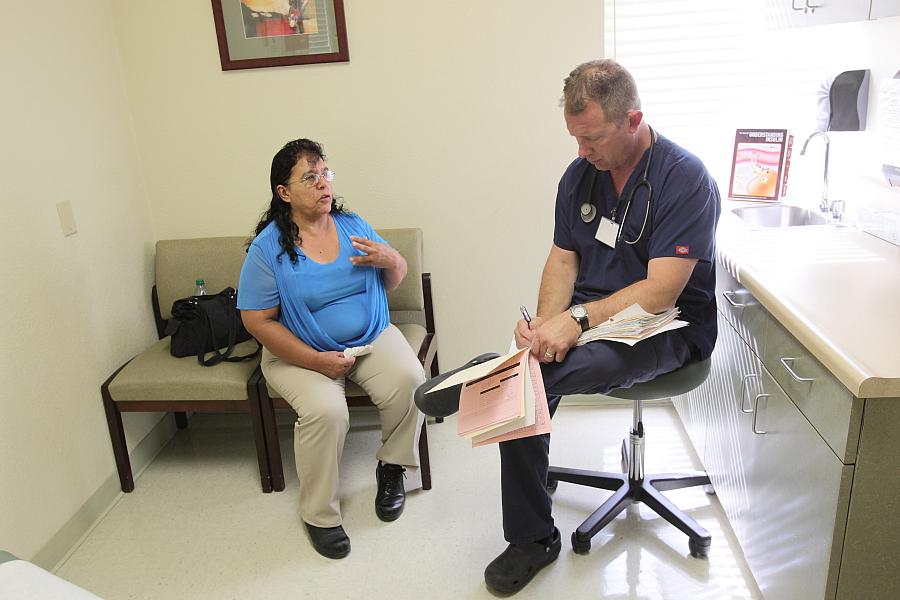New Report Finds California’s Low-Income Patients Lack Info

PHOTO CREDIT: Noah Berger, The Blue Shield of California Foundation
A new report out from the Blue Shield of California Foundation found that a majority of low-income patients in California would like more information when making medical decisions, and if that information is easy to access and understand, all the better.
That may well sound head-slappingly obvious, but the idea that a better-informed patient is a more satisfied and engaged one is especially relevant to the current plight of safety net clinics. Many such institutions are worried they’ll lose their existing low-income patient base and accompanying funding streams as health reform gives such patients more care options. Encouraging patient involvement and loyalty, the report suggested, increasingly means providers have to do a better job keeping them informed and “empowered” in their own care with the overall goal to improve patient outcomes.
For the report, the Blue Shield of California Foundation sought the opinions of more than 1,000 low-income Californians (household incomes under 200 percent of the federal poverty level), and nearly 500 residents at higher income levels, through randomized phone surveys.
One tactic to foster better informed patients, the report asserted, is to implement “team-based care,” in which a patient receives coordinated care from a doctor, a nurse or physician’s assistant, as well as a health care navigator and educator.
“Patients enrolled in team-based care, for example, are a broad 19 points more likely than others to report feeling very informed about their health and 15 points less likely to feel they need more information in order to make good healthcare decisions,” the report states.
Another element hampering low-income patient’s communication with their providers: the digital divide. New technologies can prove very useful for patients trying to access health information and communicate with their doctor, but 42 percent of low-income Californians lack Internet access (compared to 13 percent for higher-incomes), and one in five lacks a text-message-capable cell phone, according to the report.
Even among those who do have Internet access, only one-third say they’re able to have their questions answered by their provider via e-mail, the report said. But among those who can and do use e-mail or texts to communicate with their health providers, 87 percent found it useful. According to the report:
Until [I]nternet and cell phone access become more widely available, the benefits of many of the new healthcare approaches documented in this report – especially the technology advancements aimed at facilitating patient-provider communication – are largely beyond their reach.
So where are low-income Californians currently getting their health information? It turns out media sources (newspapers, TV, Internet, etc.) inch out doctors, 39 percent versus 38 percent, as the top source for health information in the low-income demographic. For the 19-39 age set, the percentage who identify the media as their top source jumps to 45.
Lest journalists and media execs get over-encouraged by their showing here, the report also notes health care professionals handily win the trust test. And for the Silicon Valley types who believe most any problem can be solved with the right app, a recent report from IMS Institute for Health Informatics suggested health care apps have a pretty lousy usefulness track record so far.
Peter Long, president and CEO of Blue Shield of California Foundation, worries a reliance on non-provider sources like media could lead patients in the wrong direction for their care. “One of the best antidotes is a strong patient-provider relationship that encourages individuals to participate in their own health and wellbeing and connects them with the right information to do so,” he said in a statement. “The health centers that act on this core finding will be that much more successful.”
The report praised medical facility patient portals and decision aids as ways of improving patients’ experiences. A patient portal is a website that typically gives patients round-the-clock access to info such as lab results, doctor appointments, email-your-doctor services, and so forth.
But all of those services can’t compete with the ultimate trump card: the doctor/patient relationship. And, perhaps surprisingly, the report found that “low-income Californians tend to have a positive relationship” with their doctor. According to the data, that’s what matters most:
As mentioned, those who report having a strong rapport with their providers are more likely than those with weaker bonds to feel very informed about their health, to be satisfied with the quality of care they receive at their facility and to trust the information provided by their doctors – all by more than 30-point margins. … Factors that contribute to a high-quality relationship between patients and providers include patients’ perceptions that their provider encourages them to take an active role in their care, having as much of a say in health decisions as they desire and self-reported information levels.
Safety net institutions that build on a foundation of solid doctor-patient relationships may well have a busier, better-funded future than those who don’t, particularly when “destinations of last resort” become one resort among many.
To read the full report or the executive summary, click here.
